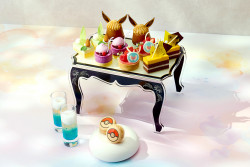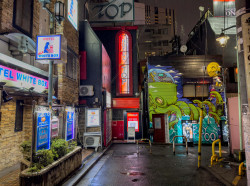
December 23, 2010
A Feast to Remember
Metropolis asks: What was your favorite meal of 2010?
By Metropolis
Originally published on metropolis.co.jp on December 2010

I had to book almost two months in advance for a counter seat at Sanpi Ryoron in Ebisu (03-3440-5572). The ten-course, ¥6,000 meal included buri sashimi with black sesame and shugiku pesto; roast salmon with grated sato imo; luscious chawan mushi with shirako and yurine lily root; and shiso sorbet and kinako ice cream. Definitely worth the wait.
Michael Kleindl reviews restaurants for Metropolis and blogs about food at www.tokyofoodlife.com
It was earlier this year, while backstage at Billboard Live, that I experienced my first toro-nama donut. A fan brought a box for the band, and after our interview, one of the members exclaimed, “Kong, you gotta try this!” I was hooked after the first bite. These intensely delicious morsels are very different from your typical doughnuts. Literally “thick” and “uncooked,” these babies are frozen instead of fried for an extreme flavor. Currently, there are 12 fruit toppings including cream cheese and mango, banana, orange and berry. The company that makes them just opened a shop in Omotesando (www.heart-bread.com/lsa/l-index.html), but I’ve also noticed them at grocery stores around the city.
Kamasami Kong is a radio DJ and producer of the Metpod
Explaining the beauty of Japanese cuisine to someone who hasn’t experienced it is never easy. Words like “fresh,” “simple” and “savory” are accurate, but they can’t convey the level to which Japanese cooking has elevated these qualities. And the food at Warayakiya in Roppongi (http://meturl.com/warayakiya) demands to be tasted. The restaurant specializes in a technique from Kochi called warayaki, burning straw rather than charcoal to grill its dishes. The blazing heat leaves the food perfectly seared, lightly infused with the straw’s subtle smoke, and succulent beyond all expectation. The only words that do this place any justice are “go” and “now.”
Clay Jarvis is an elementary school teacher and a member of several bands you’ve never heard of
Toutouan (www.toutouan.net) is a refurbished rice warehouse from a bygone era, set in spectacular gardens in Akiruno City, just one hour and a world away from Shinjuku. For me, good food and imbibing after a day of adventure makes for a winning combination—in this case, sensibly-priced yet substantial kaiseki, following a hike and onsen soak in the nearby mountain ranges. When I dined there in mid-November, the entire meal was memorable: not only for the food, but for the impact of the presentation, particularly the opening selection of nibbles, aptly served with autumnal trimmings.
John Wood is a Tokyo-based researcher, and tweets as @shitamachi66
Returning to my father’s homeland of Trinidad & Tobago for Carnival season in February was a feast for all the senses! With a huge selection of cuisine influenced by Indian, West African, Chinese and Spanish cooking, you will never starve. Eating spicy, tangy Doubles from streetside vendors in Caroni is absolute heaven. This treat consists of curried channa (chickpeas) sandwiched between two fluffy bara (fried dough) then topped off with mango or pepper sauce!
Petra Laptiste hosts Carnival-themed tours and cooking classes featuring the colorful cuisine of Trinidad & Tobago (http://tokyotrinbago.blogspot.com)
Attempting an authentic American Thanksgiving meal in Tokyo was challenging but fun. The Foreign Buyers Club (www.fbcusa.com) was the source of cranberry sauce, canned pumpkin for pies and a roaster oven. The Meat Guy (www.themeatguy.jp) provided an 18-pound bird. A trip to National Azabu (03-3442-3181) yielded hard-to-find pecans. Plans to make sautéed chard came to naught as no greengrocer in the city had heard of the vegetable.
Kevin Mcgue is a movie writer for Metropolis
I’m sitting with cloying palms and dripping brow following a barrage with winemakers the night before, and here come eight varieties of oysters—saline flats and nervy fines de claires among them—from the clutch of a tattooed butch, who offers them with brio and insight into sea temperatures and harvesting schedules, not to mention the amount of skin contact our iconoclastic Riesling has seen. Irreverent, visceral and knowledgeable—the type of service I treasure and, to an extent, that is rare in Japan. An entire lamb shoulder served to perfection with green beans follows. Diners, from jerseyed football fans to elderly couples dressed to the nines, seep out into Grand Final day from Cumulus Inc. in Melbourne (http://cumulusinc.com.au).
Ned Goodwin, who received his Master of Wine in May, is the Wine Director of Global Dining, Inc.
While I was in London, the owner of a local Indian restaurant invited my husband and me for a home-cooked dinner at his place. I was really excited to learn home-style Indian cooking. He taught me how to mix and blend the spices to make chicken korma and fish curry. It took a couple of hours to prepare. Unrolled wallpaper served nicely as a dinner table. Gathered together, I had one of the most honest and tasty dinners I can remember. That was my first experience, and I’ve been cooking many Indian dishes at home since then.
Hiromi Iguchi is a photographer based in Tokyo
Two Roman Emperors and a Pope lost their lives to a mushroom. So, by some accounts, did Buddha. The Vishnu, Krishna and Rama strands of Hinduism consider all fungi unfit for consumption, and I agree. There isn’t one variety of these spore-breeding stumps that looks, feels or tastes good to me. Yet the one dish this year I dream of eating again was 50 percent mushroom: a matsutake nigiri at Itosho (03-3454-6538), the shojin ryori restaurant in Azabu-Juban. It was soft like pumpkin, meaty like meat, and it upended one of my firmest culinary prejudices. There were a dozen other dishes, all magnificent, but it was that little gob of umami that made the meal.
Nicholas Coldicott is the Stylus.com Tokyo correspondent
When I stopped by the then-new robata restaurant Lo (www.factorylo.com), I wasn’t expecting anything too special. But from the interior decor to the food, the entire experience blew me away. Owner Takahiro Todoroki’s menu of inventively delicious kushi skewers includes Iberico pork with mikan (skin still on); hotate and zucchini brushed with olive oil and topped with ikura; and baby yari-ika stuffed with whole olives. Smart touches like video monitors set into the counter add a modern vibe.
Sarah Cortina is the assistant editor of Metropolis
I was lucky enough to dine at this unique Italian restaurant called Atrio Cucina Tacubo (http://tacubo.com) almost right after it opened its doors in Ebisu mid-October. The homemade pasta topped with white truffle was simply outstanding. But what truly overwhelmed me was a series of 12 appetizers on small plates, all meticulously prepared, and more than 30 wines by the glass. Even with so many different taste combinations, we had to pay less than ¥10,000!
Satoshi Fuma operates the website Eatpia.com
French cuisine can seem like a pricey option in Japan, but Le Dessin (www.eatpia.com/ledessin), a little restaurant in Ushigome Yanagicho, keeps things surprisingly affordable. I love foie gras, and it’s always my first choice if it’s on the menu. Le Dessin’s foie gras brulée was sublime: rich, creamy and delicious. Among the main dishes, the roast duck breast was my favorite. The serving was almost enough for two (well, two Japanese people at least), very juicy, and came with heaps of zucchini, potatoes and other vegetables. The only down side is that it takes a while to be served, as everything is done by just a husband-and-wife couple. But try it once—there’s a high chance that you’ll become a repeat customer, like I did.
Tomomi Nakagawa is a Tokyo-based PR consultant
Like every year I’ve lived in Tokyo, my best meal was at Nihombashi’s Merveille (www.augoutdujour-group.com/me). Matsumoto-san has updated his classic French food over time, but always cooks with enough freshness and excitement for two restaurants. This time, the cold lobster and eggplant salad was a highlight, but not far ahead of the foie gras rolled with walnuts and cranberries, or the beef with chanterelles, polenta and port. As usual, the staff knew just the right times to alternate between friendly, attentive and retiring. Even without the added benefit of a good friend’s company, this would have been my meal of the year.
Jon Mollenhauer blogs about food at Eating Out in Tokyo with Jon (http://iitokorone.blogspot.com)
It may seem odd to nominate a meal that left me waddling home like a less svelte version of the Michelin Man, but nothing I ate this year quite compared to the South Indian spread I had at Minami Indo Dining in Nakano (http://meturl.com/minami), a sprawling banquet of flavor-bomb dollops served up on a huge banana leaf. The pile-up of unfamiliar tastes and textures, all generously spiced, must have triggered some kind of primitive gorging reflex—I just glazed over and wolfed the whole lot down (hopefully not grunting or slathering too loudly in the process, but you never know). I wouldn’t want to eat like that every day, but just this once, being bloated felt absolutely wonderful.
James Hadfield is the editor of Metropolis
My husband and I had a fantastic meal at Suikaen (www.suiko-en.com), a peaceful kappo ryokan on the banks of the Tama River in Okutama-machi. The highlights of the meal were local fish: sashimi of yamame (Japanese salmon), salted and grilled iwana (char), and a crispy fried masu (trout) served with a sweet and sour sauce. We accompanied this with a nama honjozo from a sake kura just down the river from Suikaen. Of course, having someone bring the food to you while you are in your yukata makes the meal even more delicious. My other favorite meals of 2010 were any sashimi that my husband, a Japanese fishmonger, had made.
Yukari Sakamoto is the author of Food Sake Tokyo (The Little Bookroom, 2010)







